Observations on an Embroidered Silk Dress, English, in the University of Brighton Dress History Teaching Collection, made and altered between c 1770 -1830: issues of design, manufacture and alteration.
Professor Lou Taylor, with thanks to Dr. Charlotte Nicklas, University of Brighton, Carolyn Dowell, PhD researcher, Queens University, Kingston, Ontario, Josephine Lance, Josephine Gladstone and with thanks to Jaclyn Pyper for photography of Philip Miller, Figures of the Most Beautiful, Useful and Uncommon Plants described in the Gardener’s Dictionary, Vol 1, 1771 and thanks to the Jubilee Library, Brighton City Council, for permission to these images.
Research conducted between Oct. 31 . 2013 and April 2016.
 Introduction
Introduction
We collect altered and damaged historical dress in our Teaching Collection, some of it rejected by museums because costs of restoration are too high and serious damage means that these garments are not conventionally exhibitable. For reasons that will become clear below, even though a garment is damaged, research into such garments can however be fruitful and fresh historical information can still be unravelled.
Provenance
This damaged dress was given to us in January 2013, via Veronica Isaac, PhD researcher, Univ. of Brighton, and given to her in turn by a dress collector in the Cotswolds, Mrs Angela Hobart, of Chedworth, near Cheltenham. We are most grateful to both.
Description
Fabric
This dress is made from plain, cream-coloured English silk lustring which Carolyn Dowdell, PhD researcher on altered 18th dress, (Queen’s University, Kingston, Canada,) believes has been washed and consequently has softened and lost its high lustered sheen. There is a faint sign of colour bleeding on a very few of the flowers. The dress has been hand embroidered with sparsely scattered flowers in satin stitch and a few knot and other stitches in seven different and repeated, English wild and garden flower designs. (see below).
The Dress
The dress, which has a small size bodice, has been drastically altered and is badly damaged with a very large ragged hole in the side right of the back of the skirt with signs of staining around it. The bodice has many patches and the skirt has been neatly mended in many places. It is trimmed on one cuff, collar and centre front seams of the skirt with narrow silk fringing shaded from white to deep mauve.
The Bodice
Carolyn Dowdell, who has examined this altered 18th dress, suggests that the bodice, possibly made in the 1770s, was remade entirely in the 1780 -85, period, cut and patched probably from a matching underskirt. She notes the signs of earlier skirt waist pleating are clearly visible along the top edge of the front of the bodice on both sides. The back bodice has a few patches and a very deep V at the centre back. It is lined with quite heavy linen. The front bodice is now styled to meet at the centre front, with marked V point centre front. The basic neckline has not been altered from the c 1780-85 version but has the addition of a poorly made, vaguely ‘Van Dyked’ collar in three pieces, which may have been left after a third remake in c 1830.
The Sleeves
These are very poorly sewn. One sleeve has been left as it originally probably was- elbow length, narrow but with added fringed trimming on cuff. The other sleeve has been removed, shortened and widened. It could be that some attempt was being made here to produce short full sleeves of c 1815-1830 but the sleeve has not been gathered into a band- possibly an unfinished or abandoned project. Both sleeves are stuffed up inside with what seems to be short puffed sleeves cut from another dress maybe of the 1820s, made of glazed and stiffened white cotton covered with cream-coloured silk net.
The Skirt
Carolyn Dowdell believes that fundamentally the basic skirt is that of a Polonaise style dress of around 1775. It contains 5 widths of fabric wide. The original loops with which the skirt was lifted into its ‘polonaise’ style, are visible in the side front of the hem on both sides, with patches at the same height on each side where tapes might have been stitched or attached. The attachment of skirt to bodice has been re-arranged so the skirt meets at the centre front, probably done in 1780-85 style rather than stopping halfway round front of waist, as in 1770-75 style. It has the same added fringed trimming down front seams as on bodice.
The Floral Embroidery
The possibility that this is Indian embroidery has been suggested, but this seems unlikely due to lack of use of small chain stitched tambour work which is more typical of export–styled Indian embroidery on muslin. Neither does the embroidery appear to be Chinese-made-for-European embroidery either in stitch or mood or base fabric.
This dress is embroidered with English wild flowers in twisted, rather thick, coloured silk threads, mostly in satin stitch. Each flower is about 2 cms x 2cms., scattered sparsely over the cream-coloured silk ground. These flowers probably are:
1. Sweet Pea
2. Convolvulus- Morning Glory,
3. Harebell
4. Wild rose
5. Pansy – wild viola- ‘Heartsease’
6. Foxglove.
7. Pink or single carnation.
Comparative silk dresses of the same period with similar floral hand embroidery in coloured, twisted silk thread in satin stitch, with some French knots, and also on cream-coloured silk ground, are to be found at Platt Hall, the Museum of Costume, Manchester, the Museum of London, Worthing Museum and in the National Trust, Snowshill Collections. What is of design interest here, is that unlike the far more expensive brocaded silks from Lyon and Spitalfields, which were loaded with exotic and newly imported flower designs of primulas and lilies, for example, the embroidered flowers on all these dresses, including ours, are firmly English wild or garden flowers.
The Dress Collection at Worthing Museum, for example has:
- Dress spitalfields silm 1753, Worthing
- Fabric detail, Worthing
- Panel of dress, Worthing
- Primrose and harebell embroidery, Worthing
- Front skirt close up, Worthing
- Embroidered rose flower
- Embroidered flower detail
Dress. Museum no: 1972/59
For similarity of style see this two piece dress of polonaise & petticoat in cream silk figured with flowers & leaves & stripes, woven with sprigs of mixed flowers in pinks, cerise, greens & browns. [Images 1-3 above] Skirt with overflounce at hem & heading of gimp. Centre back of bodice boned & cut with 6 panels & runs to V, sleeves shaped at elbow, drawstring through lining at neck but no other front fastenings, inside cords for looping polonaise. Worn at Bath Assembly. Fabric possible Spitalfields about 1753-55
Unpicked dress no: 1974/168
For similarity of embroidery see this cream-coloured silk embroidered with floral sprays in reds, pinks, greens & yellow [images 4-6 above]. Garment has been unpicked. Main body of dress in several full widths of fabric open centre-front where it is edged with pinked self-fabric flounces. Front panels are cut with waist seam, where there are signs of pleating. Pocket-holes at side seams. At back, bodice & skirt cut all in one. Great width of back panel & lines of pleats suggest origin as ‘sack’. 4 separate pieces of fabric, full widths & one-long pinked piece. This embroidery is more delicate, complex and of higher quality than ours, but nevertheless there are clear similarities. With thanks for permission to use these images from the Dress Collection, Worthing Museum.
Research questions: The manufacture of floral embroidery:
Because of the similarity of the design of hand embroidered, small scattered English wild flowers found on several museum examples of late 18th century silk dresses similar to ours, it would seem clear that ours was not hand embroidered by a woman who might have made and worn this herself, as first assumed. It was, rather, the product of an organised, commercial luxury, hand embroidery trade. The three consequential areas that need follow-up research therefore are
– firstly, the issue of interest in natural science and botany in this period and the publication of magazines and books with detailed botanical plates available for con consumption by well-off women in this period,
– secondly the transfer of designs from these plates into printed embroidery pattern books from which embroiderers may have copied these similar designs,
– and finally, investigation into the commercial trade in the manufacture of this floral embroidery on women’s dress in the late 18th century.
Susan North, Senior Curator, Dept of Fashion, V and A, in an E-mail, April 9th 2013 advised us to follow up research by Claire Brown and Moira Thunder, noting also that ‘Up-to-date published research on the embroidery trade in England? Sorry none that I know of! … A new social history of 18c.embroidery is long overdue!
The contemporary evidence is there: the manuals discussing trades, crafts and professions all mention embroidery as well associated trades of pattern-drawing and the production of various threads. There are no English equivalents as substantial as Diderot or Saint Aubin, but the few ‘dictionaries of arts’ do mention some of the techniques and business practices. And then there are the insurance records, the pattern books used in other media and the botanical prints to plough through.’
Botanical Books
As interest in the natural sciences spread in the 18th century, a wealth of large size, beautiful bound botanical books and magazines were published, and sold as luxury products to wealthy consumers, with complete botanical details and large hand coloured engravings. One of these, famously, was Phillip Miller’s Figures of the Most Beautiful, Useful and Uncommon Plants described in the Gardener’s Dictionary. Volume 1 was published in 1771, ‘printed for the author; sold by John and Francis Rivington at St. Paul’s Church Yard.’ The Jubilee Library in Brighton holds a copy of this, which contains full size coloured plates of all 7 of the embroidered flowers listed above found on our altered dress. These plates are reproduced here with kind permission of the Jubilee Library and Brighton City Council.
- Heartsease, Philip Miller.
- Embroidered pansy or heartsease
- Vetch, Philip Miller.
- Blue Convolvulus, Philip Miller.
- Embroidered convolvulus flower
- Harebell, William Curtis
- Embroidered harebell or speedwell flower
- Rose, Philip Miller
- Embroidered wild rose
Our harebell plate (7 above) dates from the 1817 book publication of William Curtis’s Botanical Magazine, London, with thanks to Josephine Gladstone for permission to use this image.
Embroidery Pattern Books
Moira Thunder has written specifically about some 18th century embroidery pattern books. In her 2006 article ‘Object Lesson: Designs and Clients for Embroidered Dress, 1782– 94, Textile History (no 37, Issue 1 2006 pp. 82-90,) she discusses the lack of research on the relationships between professional pattern drawers for embroidery, professional embroiderers and amateurs. She assesses a group of embroidery designs in order to provide evidence of the technique for which they were employed; the dates and inscriptions on the designs demonstrate their use as a business archive, while the names of the clients reveal a social network.’ Her 2010, article ‘Deserving Attention: Margaretha Helm’s Designs for Embroidery in the Eighteenth Century, J9ournal of Design History, 2010, (Vol 23, no 4, pp. 409-427,) notes that ‘many seventeenth- and eighteenth-century pattern books, … show generic designs for embroidered motifs of animals, birds, plants, repeating patterns of flowers or plants, geometric patterns and borders and heraldry without specifying their application to dress or furnishings. Survival of such dress, itself, is not abundant but Helm’s pattern books do show how fashionable dress and embroidery techniques spread in eighteenth-century Europe.’ Thunder also has published further information in her book ‘Embroidery Designs for Fashion and Furnishings V and A, 2014
Embroiderers
Clare Browne’s 2009 research on Mrs Delany’s embroidery (chapter in Mark Laird and Alicia Weisberg -Roberts, Mrs. Delany and Her Circle ,Yale Center for British Art, 2009) proved that the embroidery for Mrs Delaney’s ’s court dress was professionally worked and Browne offers research on the names of these specific embroiderers.
Conclusion
Fabric:
Plain lustered silk from c 1775 commercially embroidered, probably by urban women working in a work shop, possibly in London. It features English wild and garden flower designs in satin stitch. The survival of other existing examples of late 18th silk dresses with similar embroidered floral designs confirm that this is not a one-off design embroidered domestically, for example, by the maker/owner.
The Three Life Stages of our Dress
Stage 1
A 1770-75 dress made from plain lustered silk with scattered floral embroidered which would have been worn with a stomacher, with a polonaise skirt, slightly wider shorter sleeves trimmed with ruffles, possibly a back in the ‘robe anglaise’ style and with a matching petticoat.
Stage 2
A dress of c 1780-85. The original 1770-75(?) bodice has been either discarded or cut up to help create this dress along with the original matching under – also used to form the new 1780-85 bodice, collar and sleeves. The original skirt has been re-attached, though still with the pocket slits in the original position. Carolyn Dowdell, (PhD researcher on altered 18th dress, based Victoria University, Canada) states this to be unusual.
Stage 3
Perhaps around 1830-50? This dress was altered a third and final time, most probably for fancy dress with sleeves badly altered and unfinished and an effort made to construct a ‘vandyke’ collar- in three pieces, one at the centre back with a W design and on either side. Silk fringed trimming shaded from white to mauve has been added done the centre front of dress, on one sleeve and around the collar. Charlotte Nicklas states that this could be either natural or synthetic dye.
Further research needs to be conducted to find direct design links in the c 1770 period between botanical plates, printed embroidery pattern design, commercial embroidery manufacture and our little embroidered English garden and wild flowers designs.
(Lou Taylor, April 2016.)
Read also Sarah-Mary Geissler’s blog post about her student course discoveries on an altered dress on the History of Art and Design student blog

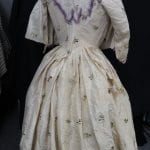















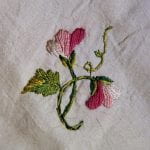



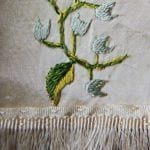
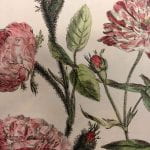


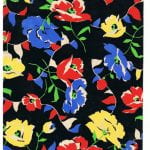



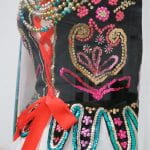





Leave a Reply